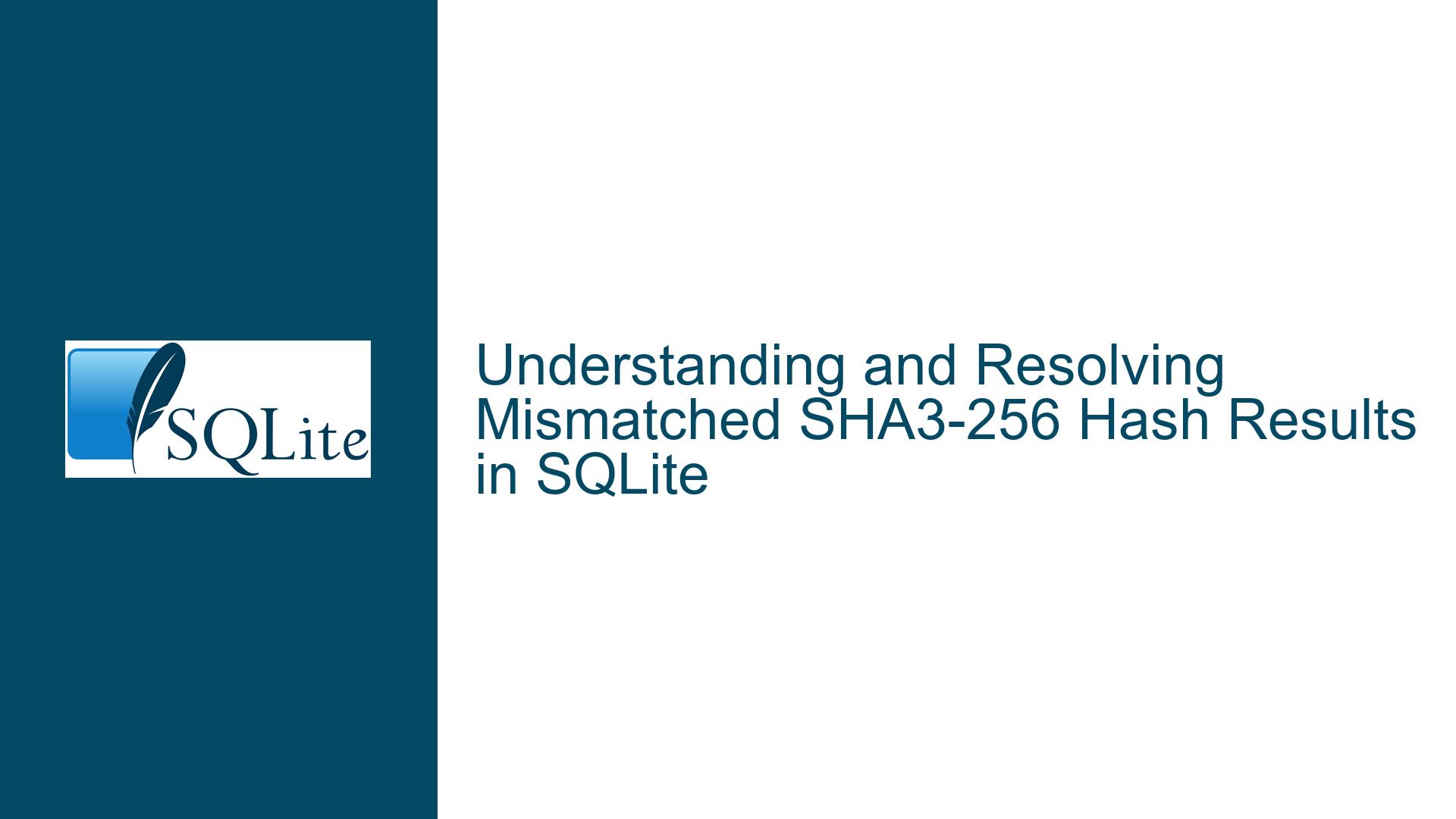and Resolving Mismatched SHA3-256 Hash Results in SQLite
Issue Overview: Mismatched SHA3-256 Hash Results Between Direct Input and Query-Based Hashing
When working with cryptographic hash functions like SHA3-256 in SQLite, it is crucial to understand the exact input being hashed. In this scenario, the user encountered a discrepancy between the hash generated directly from a value (1234) and the hash generated from a query result (SELECT ID1 || ID2 || ID3 || ID4 FROM tbl_test). Both operations were expected to produce the same hash, but they did not. This inconsistency arises from a misunderstanding of how the sha3_query function operates in SQLite.
The sha3_query function is designed to hash not only the result of the query but also the query text itself. This behavior is intentional but not immediately obvious, leading to confusion when comparing hashes generated from direct input versus query results. Additionally, the concatenation of columns in SQLite produces a text string, which may differ in representation from the binary input used in direct hashing. These nuances are critical to grasp when working with cryptographic functions in SQLite.
Possible Causes: Why SHA3-256 Hashes Differ Between Direct Input and Query Results
Input Representation Differences
Thesha3function in SQLite can accept both binary and text inputs. When hashing a direct value like1234, the function interprets it as a binary number unless explicitly cast as a string. On the other hand, the concatenation of columns using the||operator in SQLite produces a text string. For example,ID1 || ID2 || ID3 || ID4results in the string'1234', not the binary representation of the number1234. This difference in input representation can lead to different hash results.Behavior of
sha3_queryFunction
Thesha3_queryfunction is designed to hash both the query text and its results. This means that the hash generated bysha3_queryincludes not only the output of the query but also the SQL statement itself. For instance, the querySELECT ID1 || ID2 || ID3 || ID4 FROM tbl_testis hashed along with its result (1234), leading to a different hash compared to hashing the result alone. This behavior is documented but can be counterintuitive for users expecting the function to hash only the query result.Case Sensitivity in Query Text
Thesha3_queryfunction is sensitive to the exact text of the query, including case sensitivity. For example, changingSELECTtoselectorFROMtofromalters the query text, which in turn changes the hash output. This sensitivity ensures that the hash reflects the exact query executed but can cause confusion if the user is unaware of this behavior.Concatenation and Data Type Handling
SQLite’s concatenation operator (||) always produces a text string, even when concatenating numeric values. This means thatID1 || ID2 || ID3 || ID4results in the string'1234', not the binary number1234. If the user expects the hash to match a binary input, this discrepancy will lead to mismatched results.
Troubleshooting Steps, Solutions & Fixes: Ensuring Consistent SHA3-256 Hash Results
Understand the Input Representation
To ensure consistent hash results, it is essential to understand how SQLite handles input data types. When using thesha3function directly, specify whether the input is a binary number or a text string. For example:sha3(1234, 256)hashes the binary representation of the number1234.sha3('1234', 256)hashes the text string'1234'.
If the goal is to match the hash of a concatenated string, always use the text string representation. For instance:
SELECT hex(sha3(ID1 || ID2 || ID3 || ID4, 256)) FROM tbl_test;This ensures that the input to the
sha3function is consistent with the concatenated result.Avoid Using
sha3_queryfor Result-Only Hashing
If the intention is to hash only the result of a query and not the query text itself, avoid usingsha3_query. Instead, use thesha3function directly on the concatenated result. For example:SELECT hex(sha3(ID1 || ID2 || ID3 || ID4, 256)) FROM tbl_test;This approach bypasses the inclusion of the query text in the hash computation, ensuring that only the result is hashed.
Normalize Query Text for Consistent Hashing
Ifsha3_querymust be used, ensure that the query text is consistent across executions. This includes maintaining consistent case sensitivity and whitespace. For example:SELECT hex(sha3_query('SELECT ID1 || ID2 || ID3 || ID4 FROM tbl_test', 256));Always use the same query text to avoid discrepancies caused by minor variations.
Verify Hash Results with External Tools
To validate the correctness of the hash results, compare them with outputs from external tools or libraries. For example, use a PHP function or an online SHA3-256 calculator to hash the same input and verify that the results match. This step helps confirm that the issue lies within the SQLite implementation and not the input data.Document and Communicate Function Behavior
When using cryptographic functions likesha3_query, document their behavior clearly to avoid confusion. For instance, explicitly state thatsha3_queryhashes both the query text and its results. This documentation ensures that other developers or users understand the function’s behavior and can use it correctly.Consider Alternative Approaches for Data Integrity Verification
If the goal is to verify data integrity without exposing the actual values, consider alternative approaches. For example, generate a hash of the concatenated values and store it in a separate column or table. This hash can then be compared with a precomputed value to verify the integrity of the data. For instance:ALTER TABLE tbl_test ADD COLUMN hash TEXT; UPDATE tbl_test SET hash = hex(sha3(ID1 || ID2 || ID3 || ID4, 256));This approach provides a clear and consistent method for verifying data integrity without relying on
sha3_query.Test and Validate Edge Cases
Thoroughly test the hashing implementation with various edge cases, such as empty strings, null values, and large numbers. Ensure that the hash results are consistent across different scenarios and match the expected outputs. For example:INSERT INTO tbl_test(ID1, ID2, ID3, ID4) VALUES(NULL, 2, 3, 4); SELECT hex(sha3(ID1 || ID2 || ID3 || ID4, 256)) FROM tbl_test;This step helps identify any unexpected behavior and ensures the robustness of the implementation.
By following these steps, users can resolve discrepancies in SHA3-256 hash results and ensure consistent and accurate hashing in SQLite. Understanding the nuances of input representation, function behavior, and query text sensitivity is key to achieving the desired outcomes.






